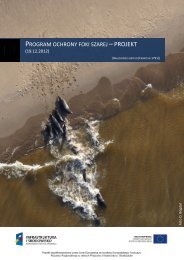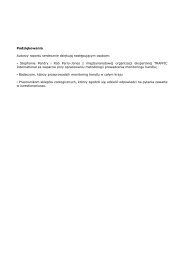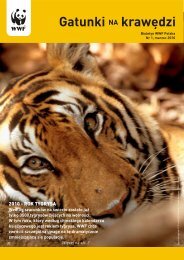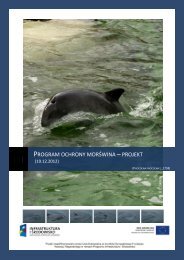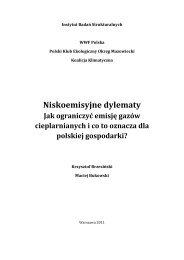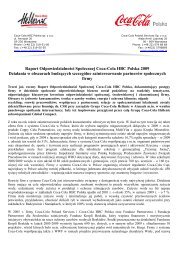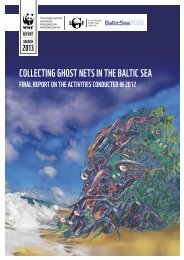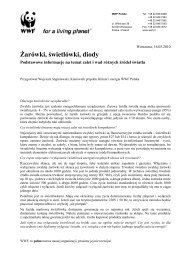Biodiversity, biocapacity and better choices
Biodiversity, biocapacity and better choices
Biodiversity, biocapacity and better choices
You also want an ePaper? Increase the reach of your titles
YUMPU automatically turns print PDFs into web optimized ePapers that Google loves.
Annex 3: Glossary of terms <strong>and</strong>abbreviations used in the reportBiocapacityBiocapacity deficitBiocapacity perperson<strong>Biodiversity</strong>BiomeCarbon budgetCarbon FootprintThe capacity of ecosystems to produce useful biological materials <strong>and</strong> toabsorb waste materials generated by humans, using current managementschemes <strong>and</strong> extraction technologies. Biocapacity is measured in globalhectares (Global Footprint Network, 2012).The difference between the <strong>biocapacity</strong> <strong>and</strong> Ecological Footprint ofa region or country. A <strong>biocapacity</strong> deficit occurs when the Footprintof a population exceeds the <strong>biocapacity</strong> of the area available to thatpopulation. Conversely, a <strong>biocapacity</strong> remainder exists when the<strong>biocapacity</strong> of a region exceeds its population’s Footprint. If there isa regional or national <strong>biocapacity</strong> deficit, it means that the region isimporting <strong>biocapacity</strong> through trade or liquidating regional ecologicalassets. In contrast, the global <strong>biocapacity</strong> deficit cannot be compensatedthrough trade, <strong>and</strong> is therefore equal to overshoot.This is calculated by dividing the number of productive global hectaresavailable by the number of people living on the planet in that year.Shorth<strong>and</strong> for biological diversity. Variability among living organismsfrom all sources including terrestrial, marine <strong>and</strong> other aquaticecosystems, <strong>and</strong> the ecological complexes of which they are part; thisincludes diversity within species, between species <strong>and</strong> of ecosystems(CBD <strong>and</strong> UNEP).A major portion of the living environment of a particular regioncharacterized by its distinctive vegetation <strong>and</strong> maintained by localclimatic conditions.The average global temperature must not rise more than 2 degreesCelsius over pre-industrial levels if we are to avoid dangerous climatechange (many Parties to the Convention have accepted this objective, asfirst asserted in 1995. A review of the objective to look at whether a 1.5ºClimit is in fact needed is scheduled for 2013-15). The 2ºC objective can befurther expressed as a global carbon budget. To have a reasonable chance(<strong>better</strong> than 50 per cent) of forestalling such a rise, cumulative globalcarbon emissions must be limited to 870 gigatons of CO2 equivalentbetween 2009 <strong>and</strong> 2100 (Höhne <strong>and</strong> Moltmann, 2009).The dem<strong>and</strong> on <strong>biocapacity</strong> required to sequester (throughphotosynthesis) the carbon dioxide (CO2) emissions from fossil fuelcombustion. Although fossil fuels are extracted from the Earth’s crust<strong>and</strong> are not regenerated in human time scales, their use dem<strong>and</strong>secological services if the resultant CO2 is not to accumulate in theatmosphere. The Ecological Footprint therefore includes the <strong>biocapacity</strong>,typically that of unharvested forests, needed to absorb that fraction ofThe CLUM model– ConsumptionL<strong>and</strong> Use MatrixCountry incomecategoriesEcologicalFootprintEcologicalFootprint: Futurescenarios(continues over)fossil CO2 that is not absorbed by the ocean (Global Footprint Network,2012). There are several calculators that use the phrase “CarbonFootprint”, but many just calculate tonnes of carbon, or tonnes of carbonper Euro, rather than dem<strong>and</strong> on bioproductive area.The CLUM presented in Chapter 1 represents the Ecological Footprintof consumption <strong>and</strong> contains three main components. The firstcomponent is short-lived consumption paid by individuals (also knownas “household” or “HH”). This component contains food, housingmaintenance <strong>and</strong> operations, personal transportation, goods <strong>and</strong>services. The second component is consumption paid for by government(called “government”) <strong>and</strong> it contains short-lived consumptionexpenditure such as public services, public schools, policing <strong>and</strong>governance, <strong>and</strong> defence. The third component is consumption for longlivedassets (called “gross fixed capital formation”), which may be paid byhouseholds (e.g., new housing), firms (e.g., new factories <strong>and</strong> machinery)or governments (e.g., transport infrastructure). These three componentssummed are equivalent to the total Ecological Footprint per nation.Countries were assigned to high, middle or low income categories basedon World Bank income thresholds. The World Bank classifies economiesaccording to 2007 Gross National Income (GNI) per person per year.This is calculated by dividing the gross national income of each country(converted to US dollars using the World Bank Atlas method), by themid-year population (for more information see The World Bank, 2012).The categories are: Low income: ≤US$935 GNI per person.Middle income: US$936-11,455 GNI per person (combines WorldBank categories of lower middle <strong>and</strong> upper middle income).High income: ≥US$11,456 GNI per person.A measure of how much biologically productive l<strong>and</strong> <strong>and</strong> water anindividual, population or activity requires to produce all the resourcesit consumes, <strong>and</strong> to absorb the waste it generates, using prevailingtechnology <strong>and</strong> resource management practices. The EcologicalFootprint is usually measured in global hectares. Because trade is global,an individual or country’s Footprint includes l<strong>and</strong> or sea from all overthe world. Ecological Footprint is often referred to in short form asFootprint (Global Footprint Network, 2012).This “business as usual” scenario has the following assumptions: (a)Global population of 9.3 billion by 2050 (UN, 2010 Medium variant);(b) Total energy dem<strong>and</strong> doubles from 2005 levels (IEA Business asUsual from IEA, 2008); (c) Increasing dependency on coal for powergeneration from 45% in 2005 to 60% by 2050 (IEA Business as Usual);(d) 12% increase in caloric intake per person, with an increase in theamount from meat, milk, <strong>and</strong> dairy; decrease in amount from cereals <strong>and</strong>fish (FAO Agriculture Towards 2030/2050 FAO, 2006); (e) Constantcrop <strong>and</strong> forest yields based on 2005 figures; (f) Increase in crops fedto animals (FAO Agriculture Towards 2030/2050, FAO, 2006); (g)Increases in atmospheric CO2 <strong>and</strong> methane concentrations associatedWWF Living Planet Report 2012 page 146 Annex: Technical notes <strong>and</strong> data tables page 147



